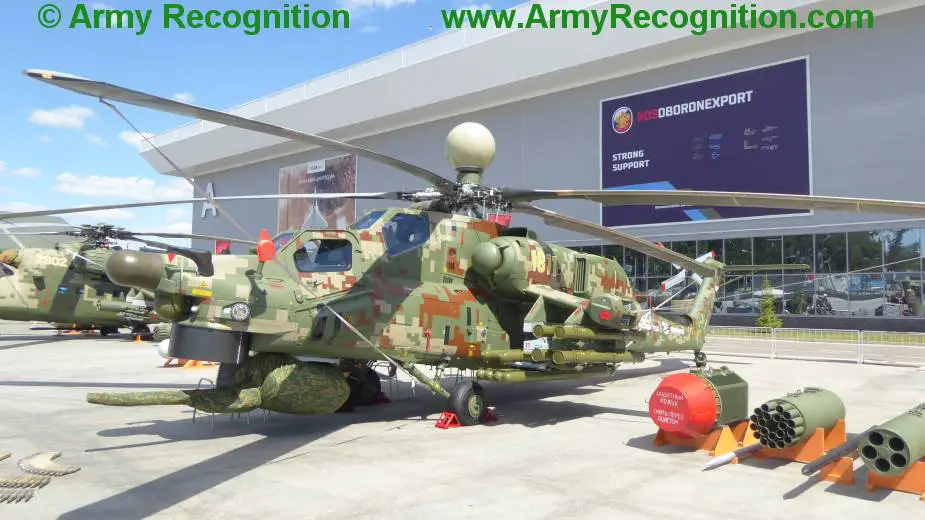The Russian Ministry of Defense (MoD) has approved a renewed schedule of the delivery of Mil Mi-28NM combat helicopters to the troops, according to the Izvestia newspaper.
Follow Air Recognition on Google News at this link

The Russian industry is set to deliver to the military the first two Mi-28NM of 98 ordered before the end of 2020. In 2021, three helicopters of the type will be manufactured; those platforms will be used for trials and crew training. An Mi-28NM wing is believed to have enough firepower and other capabilities to replace a squadron of existing Mil Mi-24 (NATO reporting name: Hind) gunships.
Unspecified sources in the MoD told the Izvestia that the delivery schedule of the first two Mi-28NM had already been approved. The platforms will be handed over to the troops before the end of 2020. In 2021, the military is set to receive three more rotorcraft of the type. The platforms will be operated to train crews; the helicopter’s manufacturing rates will be dramatically increased in the coming years.
In September, Director General of Rostec’s holding Russian Helicopters Andrei Boginskiy said the first Mi-28NM was passing through its trials, while the second was testing new high-speed blades of its main rotor.
The Izvestia previously reported that the joint state trials of the Mi-28NM rotorcraft were to be finished before the end of the year. The contract for the Mi-28NM was signed in 2019, and the military will receive 98 such rotorcraft through 2027.
According to the former commander of the 4th Air Force and Air Defense Army Lieutenant General Valery Gorbenko, the Mi-28NM will be capable of conducting its tasks in a more effective way compared with the combat helicopters of previous generations. “The military has an urgent need in the new rotorcraft as Mil Mi-24 and Mi-8 platforms are still in use. The Mi-28NM with advanced targeting system and weapons will replace the Mi-24. The Mi-24, which saw combat use in Afghanistan, has worn down its resource. The Mi-28NM is a round-the-clock machine, and its effectiveness is higher compared to that of the helicopters of previous generations. The use of the new rotorcraft will save spare parts, fuel, and ammunition, and will extend the service life of the engine,” said Gorbenko.
The Mi-28NM has almost all its components upgraded. The system’s weapon suite will be reinforced with the Izdeliye 305 (Unit 305; also known as LMUR) long-range missiles, which are reported to have a range of some 15-20 km.
The new helicopter’s N025 mast-mounted radar will increase the accuracy of the helicopter’s weapons. This system will also allow the crew to fly the machine round-the clock at all altitudes, including extremely low ones. A fully rebuilt targeting subsystem with more powerful day and night sensors will support new long-range weapons.
The new rotorcraft is powered with Klimov VK-2500P turboshaft engines, which are produced in Russia under the import substitution program. This powerplant and new high-speed main rotor blades will increase the speed of the helicopter by 10-13%, according to the Izvestia. Each pilot is now capable of controlling the rotorcraft; therefore, there is no need to procure designated training helicopters.
The baseline Mi-28N (Havoc-B) ‘Night Hunter’ combat helicopter was being tested between 1996 and 2008. However, the rotorcraft was finally adopted only in October 2009. The development of the system’s modernized variant started in 2016. According to the Izvestia, the upgraded helicopter saw combat action in Syria in 2019.
Mi-28NE
Export version of the Mi-28N. In service with the Iraqi and Algerian Air Force. In August 2018, Russian Helicopters unveiled an upgraded Mi-28NE variant, with improvements made in the main rotor system and engine unit and new on-board radio-electronic equipment. The helicopter has enhanced armor and is fitted with modern directional IR countermeasures (DIRCM) against short-range IR guided missiles. Its rotor blades made of composite materials can withstand shells up to 20–30 mm, while the fuel system is to be fire and explosion resistant. It will be also capable to use the new 9M123 Khrizantema-V anti-tank guided missiles (ATGMs).
Mi-28NM
An upgraded version of the Mi-28N under development since 2009. The helicopter has redesigned nose hull due to removal of its nose antenna, new H025 radar station for all-round visibility, more powerful VK-2500P engines with FADEC instead of the previous Klimov TV3-117VMA engines and improved rotor blades to increase its maximum speed by 13% and cruise speed by 10%. Besides that, it has an upgraded fire-control system and new "Izdeliye 296" onboard radio-electronic data processing system. It will be equipped to carry the 9M123 Khrizantema-V and 9M127-1 Ataka-VM anti-tank missiles. It is also planned to be equipped with the new "Izdeliye 305" or LMUR (Light Multi-role Unified Missile) multi purpose missile, designed for use against air and ground targets, and fitted with inertial guidance in initial flight, with mid-course updates by an operator before the target is acquired by the missile's own seeker, giving a range of 25 km (16 mi). The Mi-28NM made its maiden flight in October 2016 and the state trials of the upgraded VK-2500P engines were completed in October 2020.
© Copyright 2020 TASS. All rights reserved. This material may not be published, broadcast, rewritten or redistributed.
















